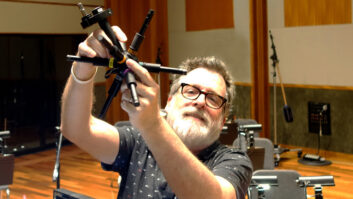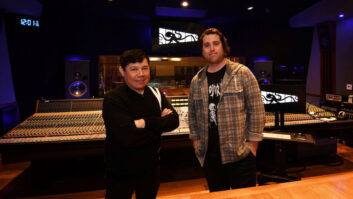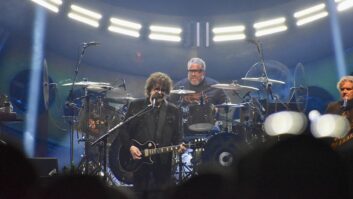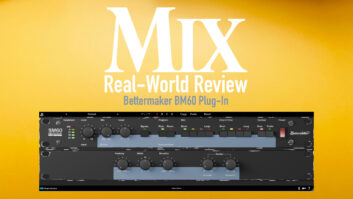“Beautiful, isn’t it?” Gomez said. She seemed to sense that he was uneasy.
“Yes, beautiful,” he answered. But he didn’t feel that way at all; something about this forest struck him as sinister. He turned round and round, trying to understand why he had the distinct feeling that something was wrong with what he was seeing. Something was missing or out of place. Finally, he said, “What’s wrong?”
She laughed. “Oh, that,” she said. “Listen.”
I knew the movie version of Timeline, Michael Crichton’s latest Cassandrian sci-fi tome to get the Hollywood treatment, was going to be a stinker when I saw the preview. It came on before School of Rock, and it was way, way louder than anything Jack Black could coax out of those precocious kids and his van full of amps. It featured stampeding horses, clashing armor, and various and sundry explosions, all of which had precious little to do with the 14th-century world that Crichton, in his usual convincing fashion, had constructed in his novel.
Chris stood silently for a moment, listening. There was the chirp of birds, the soft rustle of a faint breeze in the trees. But other than that…
“I don’t hear anything.”
“That’s right,” Gomez said. “It upsets some people when they first arrive. There’s no ambient noise here: no radio or TV, no airplanes, no machinery, no passing cars. In the twentieth century, we’re so accustomed to hearing sound all the time, the silence feels creepy.”
And not only do we hear sound all of the time, but it’s loud sound, and it’s getting louder. The amount of noise that we put up with in our average existence is, when you think about it, pretty awful. So I thought I’d talk this month about noise, environmental and otherwise.
When was the last time you really heard silence? I mean outside of a well-built studio or when you didn’t have heavy-duty headphones clamped on your skull. The neighborhood where I live is known as one of the quietest in the Boston suburbs. When a teenage driver honks his horn at night to announce his arrival at a friend’s house, neighbors complain to the parents. People tend to not set their car alarms, because they know how annoying they can be when they go off. Stepping onto my front porch on a calm January weekend evening, when there are no insects spreading their aural blanket and birds aren’t yet rolling out their mating calls, the world seems, at first blush, silent. But after a few seconds, I realize I can easily hear the traffic on the freeway over a mile away, the buzz of a transformer on a pole overhead, a distant police siren, someone on the next block starting their car and the endless procession of jets arcing up from Logan Airport, eight miles distant. It’s noisy out here.
Inside my house, with the Anderson double-paned windows shut tight against the cold and noise from outside, I can hear the furnace in the basement, the 60Hz hum from the light dimmers in the kitchen, the low rumble from the oil delivery truck down the street, the ticking of the security timer in the closet, and, of course, the fan and disk drive in my computer. It’s noisy in here, too.
Few of us today really know what silence is, and since the beginning of the Industrial Revolution, the level of background noise has been constantly rising. Ironically, city streets may be one of the few environments where this trend has managed to reverse itself, at least a little: Recent efforts to improve traffic flow, make horn-honking a violation and tighten restrictions on car and truck exhaust noise have successfully reduced the ambient level in many urban cores. But as the streets may have become slightly less oppressive, many indoor environments are significantly more so. Who can walk into a modern office building or hotel lobby without feeling assaulted by the awful background music, the splashing from fake waterfalls and the walla from the coffee shop and bar amplified a hundredfold by the vaulted glass ceilings?
Even spaces that are supposedly designed for listening are becoming aurally unfriendly. My wife, a professional storyteller, performs for children in schools and libraries. When she first started, it was no problem to do a show for 100 children without electronic assistance, but in newer buildings, she finds that she needs a sound system for groups of 50 or even fewer, unless she wants to come home with laryngitis. It’s not that the kids are noisier — she’s really good at getting them to be quiet — it’s that she has to make herself heard over the ubiquitous “air exchange” systems: positive ventilation systems that seem to have been installed primarily to protect the builders from lawsuits resulting from “sick building syndrome.” Teachers, librarians and even custodians are often powerless to shut them down, as they’re on undefeatable timers. No doubt that representatives from the schools carefully considered lots of data when they spec’d these systems, like air volume and energy use, but unlike when you put in that ventilation system in your control room, no one at the school board thought to ask how loud it was going to be. That’s too bad, because those systems deny the students the power and magic that come with direct, personal contact with a performer. Not to mention they throw away any effort or money spent on room acoustics.
There’s a new trend in doctors’ offices that you may have noticed. As medical practices get larger and more practitioners are crammed into smaller spaces, patient confidentiality is endangered because it’s harder to keep those in adjacent treatment rooms from overhearing each other’s complaints. So have office designers tried to acoustically isolate the rooms better? No, they buy doctors machines that generate white noise to cover up the conversations. They are effective unless the patient has a hearing problem, in which case the whole office can overhear the doctor shouting.
Theaters are getting louder, too, but not because of bad design. The days when someone like Rex Harrison, whose singing voice could hardly be called operatic, could be heard in My Fair Lady as clear as a bell in the back row of the balcony at the Mark Hellinger Theater are long gone. Harrison, or for that matter a vocal powerhouse like Bernadette Peters, can’t keep up with the elevated sound levels that people expect to hear today, especially if they’re going to make it through eight shows a week. Audiences are accustomed to loud music in their homes, in their cars, at the movies and at concerts, and so they expect to get the same impact from theater orchestras, which means that even the best singers need help to be heard.
It’s not a good trade-off. I know I’m hopelessly old school, but I can’t think of a single theatrical performance I’ve ever seen that used amplification and didn’t suffer because of it. I recently saw a one-man, one-set historical play in a 350-seat theater performed by an actor with a well-trained, but not overwhelming, voice who didn’t need a sound system to be heard over the minimal music and sound effects. The audience came out chattering excitedly about how close they felt to the character, and how extraordinary it was to spend all that time in the same “room” with him. You don’t hear that kind of reaction when actors wear mics, no matter how well-concealed and amplified.
People are so used to oppressive noise levels that they don’t even know when they’re being assaulted. Some years ago, I moved to a town where a fire horn (the locals called it a “whistle,” but it was actually around 300 Hz) blew three times a day. The first 18 months I lived there, the horn was broken, so I was completely unaware of it. But then they fixed it, and when I first heard the thing — which was well over half a mile from my house — blow at noon one day, I literally fell off my chair. And when it blew the next morning at 6:45 a.m., which I found out it was supposed to do every day (as well as at 6:45 p.m.), I got furious.
A few of us recent arrivals who hadn’t known about the horn — a group that included healthcare workers, teachers, psychologists, scientists, journalists and other low-lifes — started a referendum drive to get it shut off. (We also considered getting a bylaw that would require real estate agents to show properties in the area only at noon and 6:45 p.m.) But we were outvoted by older members of the community who wanted to keep the monstrosity for its nostalgic value: Once upon a time, it seems, the signal was used to wake up local mill workers so they could be sure to get to their jobs on time — menial, dangerous and underpaid as they were — and a whole lot of people felt it was somehow crucial to the character of the town to preserve that miserable tradition.
Eventually, we got an engineer from the state’s Environmental Protection Agency to come in with a sound level meter and measure the thing from inside the apartment of one of our members — a nurse who worked the night shift — in a new high-rise right across the street from the monster. It checked in at 138 dB, which was high enough for the state agency to tell the town that if they kept blowing the wretched thing, they would be fined $1,000 a day.
Sadder still is when people — and governments — don’t know when the sounds around them are actually beneficial. At the end of last year, the agency that runs the Boston subway system declared that live music played in the stations created a safety hazard and tried to shut down the practice. The recommendation to do so, the agency said, came from a task force on security that was set up in response to the September 11th attacks. The music, the agency conjectured, might drown out crucial security announcements on the P.A. system. The decision set off a flurry of activity in the newspapers and on the Web, and within a couple of days, 8,000 supporters of subway music — including Grammy-winner Tracy Chapman, whose career was launched in these same subways, and singer Peter Mulvey, who actually had the guts and patience to recently record an album in the Boston underground — signed a petition supporting the performers.
In the face of the petition, and after a number of newspaper articles pointed out that the musicians are often the only ones who actually understand what the P.A. systems are saying, and that they, with their reasonably good vocal mics and modern amplifiers, would be much more effective at getting an important message to a crowd of people than a station agent with a Dorchester accent in a glass booth 50 yards away squawking through a moldy carbon mic and a 50-year-old grime-encrusted speaker, the transportation agency backed off. But they stipulated that there were to be no drums or even electronic simulations of drums, and no trumpets, although French horns, soprano saxes and electric violins were perfectly okay. So Roland Kirk would be fine, but not Miles.
Furthermore, sound levels were limited to 80dB SPL at 25 feet from the source (not, as one of the local NPR stations reported, 800dB SPL, which would be roughly the sonic level of the Big Bang). That rather odd spec works out to about 98 dB at three feet, which is pretty respectable, even on a subway platform. One official described the new spec as “akin to positioning your ear directly over a garbage disposal while it’s operating.” While he’s not too far off, my guess is that this guy is not a music lover. I imagine he’s happy that there’s little danger the music would ever cover up the hideous sounds the train wheels make as they grind their way around the old system’s tight curves.
Like children who grow up in the city having never seen the Milky Way, we’ve lost our appreciation for silence. Those who question how their world is changing for the louder and noisier are few and far between, and are easily drowned out. And it’s particularly ironic that it’s getting worse while the dynamic range of our audio systems is getting bigger. What’s the point of being able to deliver 24-bit recordings to a world where the ambient noise level never drops below 60 dB? Well, I guess if we can’t find a time machine, there’s always headphones.
Paul Lehrman sometimes finds himself looking for a way back to 1968. It was noisy, but at least it was fun.







